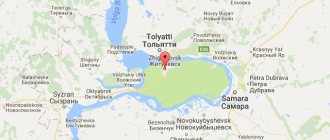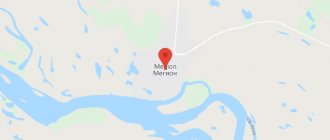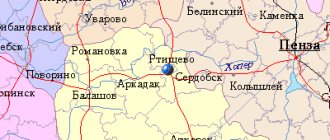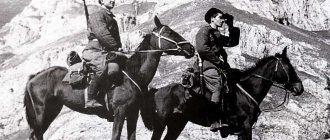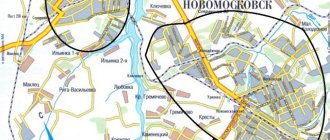Novouralsk is a city built on the border between Europe and Asia in 1946. The history of the formation of such “closed” cities is connected with the beginning of the development of uranium by Soviet scientists and the creation of the country’s “nuclear shield”.
THEN Novouralsk was founded as a factory city, where already in 1949 scientists were able to produce material for creating an atomic bomb. The western shore of the Verkh-Neivinsky pond was chosen for unprecedented construction. On the map of Novouralsk from a satellite you can see the location of the city. It is surrounded by mountain slopes from the south and southeast:
- Bear;
- Hanging stone;
- Semi-factory;
- Chuvalovskaya.
To the west, the city is surrounded by dense mountain forests, and the northeastern part is comfortably “settled” in the upper reaches of the Neiva River. From Novouralsk to Yekaterinburg it is about 60 km along the highway. The map of Novouralsk with diagrams shows that the city, like most closed settlements, is located far from federal highways. The nearest highway R-352, connecting Yekaterinburg and Nizhny Tagil, runs 20 km from the city.
general information
Novouralsk is the administrative center of the city district of the same name. It is located 54 km northwest of Yekaterinburg. The city territory covers an area of 3,150 hectares. From 1954 to 1994 the city was called Sverdlovsk-44.
The city has the status of a closed administrative-territorial entity of the Sverdlovsk region. A fence with barbed wire has been built along the perimeter, and there are 10 checkpoints. The population of Novouralsk has permanent passes. Nonresidents and relatives can apply for a temporary pass, which is usually done within at least two weeks.
Novouralsk is one of the country's first centers for the development of the nuclear industry. The city-forming enterprise is the Ural Electrochemical Plant, the world's largest producer of uranium isotopes. The scientific and industrial complex of the nuclear industry employs, among other things, 52 doctors and candidates of science.
Map of Novouralsk with houses. City architecture
In terms of the quality of life of citizens and amenities, Novouralsk can be called one of the advanced cities of this type. Infrastructure, trade and social services for citizens are well developed here. On the territory of the city, its residents and a few guests are served by:
- About 100 trade enterprises;
- 2 markets;
- 50 canteens, cafes and restaurants;
- Household service;
- Post office;
- 4 hospitals and 7 clinics;
- 3 dispensaries.
Those who first arrived in the city to visit relatives or on a business trip will definitely need such an indispensable assistant as a map of Novouralsk with houses. On it you can find both residential buildings and organizations and institutions.
Novouralsk is a modern scientific and industrial center. Its architecture is represented by modern high-rise residential buildings and Soviet-era buildings that house libraries, a theater, and cultural centers. The city is distinguished by its cleanliness, smooth, neat roads and well-groomed, albeit few, monuments. Local residents recommend seeing:
- Water tower;
- Church of St. Seraphim of Sarov;
- Former post office building;
- Operetta Theater of the Urals.
Foundation of the city
Initially, it was planned to build a resort on the banks of the Verkh-Neivinsky pond, one of the most beautiful places in the Urals. There was the purest air here, various types of trees grew on the mountain slopes, and there were a lot of fish in the reservoirs. There was a railway station nearby, and a short distance separated it from the regional center. In 1926, a rest house for railway workers was built. In 1939-1941, two more sanatoriums were built - for machine-building workers (currently the Cape Verde holiday home). So the first population of Novouralsk consisted mainly of vacationers.
In 1941, the Soviet government identified a site for the construction of plant No. 484 (Ural Electrochemical Plant) measuring 389 hectares, of which 187 hectares were allocated for the city itself. By July 1941, a cement warehouse was built and 25 tents were erected for construction workers. At the same time, the construction of a plant for the production of small prefabricated panel houses began. Already in the fall of the same year, the Pervomaisky settlement was built, consisting of 25 four-room houses, each of which lived two families. The population of Novouralsk aptly called them plywood yurts or fanzes. In total, 2,500 people were employed in construction work.
Novouralsk
Plans for the construction of a resort town
The emergence of Novouralsk was preceded by the development of vacant land located in the vicinity of the Verkh-Neyvinsk railway station, built in 1878 on the Yekaterinburg - Nizhny Tagil line. The choice of location for the construction of the new city was not least influenced by the presence here of the most beautiful corner of the Ural nature - the Verkh-Neivinsky pond, surrounded by mountains and connected by a channel to Lake Tavatuy.
In the 1930s It was planned to build a resort town on the banks of the Verkh-Neivinsky pond. In 1926, southwest of the Verkh-Neyvinsk station, the Sverdlovsk branch of the Perm Railway began to build a rest house for railway workers. On the slopes of the mountains surrounding the Verkh-Neivinsky pond, numerous species of trees grew, there was the cleanest air, a large reservoir was rich in fish, and the regional center and railway station were located nearby. N.K. Salamatov was appointed the first director of the rest home, and V.M. Tsapaev replaced him. A country train ran from the Sverdlovsk station to the Verkh-Neyvinsk station, and since 1935, after the complete electrification of the Gornozavodskaya Railway, electric trains ran along this line.
By 1937, the All-Union Trust "Sovkhozstroymaterialy" on the right bank of the river. Bunarki, a car garage was built at the Verkh-Neyvinskaya timber depot with a room for car repairs, covered parking for cars, an above-ground warehouse for fuels and lubricants and other premises. In 1937–1939 the head of the garage was N.P. Cheblakov. In 1939, on the site where boarding school No. 53 is located today, they began to build a sanatorium for workers. Two two-story wooden buildings for vacationers, a club-dining room, two one-story cobblestone houses for employees, a boiler room, a pumping station, and a power station were erected. At the beginning of 1941, the sanatorium began its work. At the same time, in 1939, construction began on the rest house for railway workers and the Rosglavkhleb trust (today it is the Green Cape rest house).
At the origins. Unnamed village in the 1940s.
In March 1941, the USSR Government approved a site for the construction of plant No. 484 (now the Ural Electrochemical Plant), the size of the allocated site was 389 hectares, of which 187 hectares were allocated for housing and household services. The choice of a construction site near the Verkh-Neyvinsk railway station was not accidental. There was everything necessary here: the proximity of raw materials, energy, forest and water resources, metallurgical enterprises, the availability of qualified personnel. The boundaries of the territory of the future plant and the factory village ran along the railway (from the east) and along a diversion canal (from the west and north), including the Verkh-Neyvinsk station and the fourth industrial site. The first to be built was a small cement warehouse, made from boards, at the crossing across the Bunarka River to. In July 1941, 25 tents were erected at the foot of the Ural Mountain.
The construction of a resort city was becoming a real prospect, but the war made adjustments to these plans.
In July 1941, on the site where Zarechnaya Street runs today, construction began on a woodworking plant that produced small panel houses. And already in the fall, behind the Ural Mountain, the first panel prefabricated houses appeared, forming a settlement called the village of Pervomaisky. In August 1941, 25 lightweight four-room houses, which were called “plywood yurts” or “fanzes,” were built; now in their place is the Rodina cinema. Each yurt was designed for two families. In October 1941, about 2.5 thousand people were employed in construction work.
In September, the buildings of the Ural Mashinostroitel sanatorium were transferred to a hospital; after their conversion, they housed the Arkhangelskoye Central Sanatorium-Hospital of the Red Army, evacuated from the Moscow region. The wounded were brought here for further treatment from other hospitals. After completing a course of treatment, the soldiers again went to the front.
The first builders of Novouralsk were allocated prefabricated panel barracks for living, produced by a local house-building plant. The houses were assembled on site. The first barracks were located in groups - separate villages. Following the village of Pervomaisky, others were formed: Permanent, Plywood, Temporary, B. Gulag. All these villages were listed on the 1944 general plan.
During the war years, 9,600 square meters were built. meters of housing in barracks settlements, of which 4,700 sq. meters of permanent houses. By the beginning of 1942, the construction of 9 barracks in the Temporary Village was completed, military construction workers were stationed here, a canteen and the first elementary school with two classrooms were opened in the village. The construction of the barracks was carried out by prisoners from ITL-100 and military construction battalions. 6 separate camp points were formed, the number of prisoners in which was 8,100 people. Prisoner labor was used in construction until 1953.
In 1942, residential buildings No. 33–37 were built in the Permanent Village. These 12-apartment wooden houses can still be seen today on Lenin Street, the main street of Novouralsk. It was decided to preserve them as a memory of the city’s past, while the interior was reconstructed and the houses were tiled. At the same time, Station Street began to form (now M. Gorky Street), which became one of the first streets of the future city. There were only 6 houses on one side of it. There is information that back in 1941 the builders commissioned: a wooden department store, a bathhouse, store No. 1 (general) and store No. 2 (for engineering and technical personnel), three vegetable stores, and a bread stall. In the “Plywood” village there were a communications center, a post office, a kindergarten, a shoemaker’s and a tailor’s workshop. Later, a school was moved here from the Temporary Village.
In the spring of 1944, Plant No. 261, which produced aircraft chassis, was relocated to the construction sites of plant No. 484 from the city of Berezovsky. Plant No. 484 was merged with the Berezovsky enterprise. The combined plant was named the State Union Plant No. 261 of the People's Commissariat of the Aviation Industry, it worked until the end of 1945. During the war years, the builders of the People's Commissariat of the Aviation Industry built up an area of 258 hectares with industrial facilities, which in December 1945 was transferred to the builders of the nuclear industry plant, in including the main building with a total area of 29 thousand square meters. m, which became the basis of the future UECP plant - the Ural Electrochemical Plant.
The formation of the city of Novouralsk is primarily associated with the Ural Electrochemical Plant. In December 1946, for the construction of plant No. 813 (production of highly enriched uranium, the future UECP), Construction Administration No. 865 was created, which began construction of the plant and residential village on January 1, 1946. In 1949, just three years later, the company produced its first product - material that was used to create the first Soviet uranium atomic bomb. The plant became the first industrial enterprise in the USSR to specialize in the separation of uranium isotopes using the gas diffusion method.
Sverdlovsk-44. The city in the 1950s–1960s.
Since 1946, low-rise permanent buildings have been built on the basis of the plant's construction. The workers' settlement, which developed together with the plant, was transformed into the city of Novo-Uralsk by the Decree of the Plenum of the Supreme Soviet of the RSFSR of March 17, 1954, but for almost 40 years the city continued to live under the numbered name Sverdlovsk-44. In accordance with the resolution of the Council of Ministers of the USSR dated April 6, 1950, multi-storey development of Novouralsk began. In 1948–1951 the city's population was about 20 thousand people.
In 1954, the plant began producing low-enriched uranium for reactors at nuclear power plants, research reactors, and reactors at marine power plants. In the same year, the company was awarded the Order of Lenin.
On April 23, 1956, a session of the City Council was held, at which a master plan for the development of the city was approved, which provided for a significant increase in the pace of housing construction, as well as landscaping along the Bunarka River, the construction of a new hospital complex and a bakery. On February 9, 1959, the following figures were announced at a session of the City Council: in the period 1957–1958. in the city, 37 barracks were demolished, 42 houses were put into operation, living conditions were improved for 1,450 families, 4 preschool institutions, a boarding school, school No. 45, a children's hospital, a sanitary and epidemiological station, a bakery, a hostel were built and put into operation on Sverdlova Street, 8 shops. A lot of work has been done on landscaping and beautification of the young city. Over the next two years, 1959–1960. 17 more barracks were demolished, 31 residential buildings were commissioned. Mostly, construction took place on Stalin (now Lenin), Pervomaiskaya, Furmanov, Sportivnaya, Privokzalnaya, Sverdlov streets, in Teatralny Proezd and Zeleny Settlement.
In the 1950s–1960s. The favorite vacation spot for residents of Novouralsk was Osinovaya Mountain, on the slope of which the UEIP Culture House is located. At the top of Osinova there was a summer theater, there were gazebos and a dance floor, below there was an amusement area that existed until the end of the 70s. XX century.
Since 1965, the Western district along Bunarskaya Street began to be built with five-story buildings. In 1967, a decision was made to build the Ural Auto Parts Plant, a branch of the Moscow Automobile Plant named after I. Likhachev. Already in November 1968, the plant produced its first products, and on July 14, 1976 it was renamed UAMZ - Ural Automotive Plant. Production grew, and the city grew along with it. The average volume of housing built annually reached 30 thousand square meters. m.
In the mid-1960s, the residential area between Komarova Street and Parkovy Proezd was improved. At the end of the 1960s. In Novouralsk, a House of Pioneers and Schoolchildren, a mud bath, a Sports Palace (including a swimming pool), the Kedr sports complex, SPTU-2, and a ski base were built. A children's sports school has opened.
1970s
Since the 1970s Separate comfortable microdistricts of multi-storey residential buildings are being built in the city. Active housing construction is underway along Avtozavodskaya, Komsomolskaya and Yubileinaya streets. By the end of 1970, the housing stock of Novouralsk amounted to 1,643 thousand square meters. meters of total area, 80% of families were provided with separate apartments. In 1970, the Neiva widescreen cinema opened in the city, and in the same year a music school with a large concert hall was built. During this period, a children’s clinic, school No. 47, the “Sapozhok” and “Silhouette” studio, the “Malysh” and “Zarya” stores, as well as facilities on Komsomolskaya Street: a district clinic, a children's factory, a cafe, a shoe and bookstore were put into operation , rental salon.
In 1973, the Leningrad Design Institute completed the development of a master plan for the city for 20–25 years. In the same year, the last barracks located on Shevchenko Street were demolished, the Stroitel club, five children's centers, and the Verkh-Neyvinsk station were put into operation.
By the mid-1970s. the population of Novouralsk exceeded 71 thousand people. In 1975, a local history museum was opened in the city, and a new shopping center was put into operation on Komsomolskaya Street.
In February 1977, a car assembly shop was launched at the Ural Automotive Plant (UAMZ), which was a branch of the ZIL production association. In 1978, 163 cars were assembled here, in 1979 - 2,591 cars, in 1980 - 7,045 cars. The plant constantly increased its capacity and over time it produced up to 18 thousand ZIL-157KD vehicles per year. In 1987, UAMZ began production of ZIL-131.
For the 20th anniversary of the city, the leadership of the city committee decided to lay an alley of Labor Glory along the Bunarka River, paying tribute to the workers of the Novourals and beautifying the banks of the river. Along the alley there are fountains built without drawings; MSU installers built them using the selection method in the form of energy levels. A monument in the form of a stylized sickle and hammer was erected here - a symbol of labor. On the high-rise buildings, inscriptions in huge letters “Glory to the leaders of production” and “Glory to labor” were lit up, and portraits of the leaders appeared on the Board of Honor.
Novourals residents decided to celebrate the 30th anniversary of the Great Victory by building another alley - Battle Glory. And in 1975, an alley with an abundance of green spaces and flower beds was built with the active participation of citizens on the site of old buildings. The alley was crowned by the Victory Monument with the Eternal Flame. The perimeter of the square was decorated with thirteen pedestals, according to the number of hero cities in which shell casings with sacred earth from mass graves were walled up. Today, the Walk of Military Glory is a meeting place for front-line soldiers.
Three years later, the idea with alleys found its logical continuation. For the 60th anniversary of the Komsomol, below the Alley of Labor Glory, the Alley of Youth was founded, in the construction of which Novouralsk Komsomol members quite naturally took part. The alleys have become a decoration of Novouralsk and a popular recreation area for citizens.
At the request of the Council of Veterans and in connection with the 30th anniversary of the Victory, by decision of the Executive Committee of the City Council, Bunarskaya Street was renamed Victory Street. In 1979, for the 25th anniversary of the city of Novouralsk, the “Green Ring” was created, uniting all three previously built alleys and three more not yet born. Along the bank of the Bunarka River and Yubileinaya Street, an area was cleared, which was decorated with wooden sculptures and benches, calling it Educational Boulevard - after the nearby training center of the Sredneuralsk Construction Administration. The vacant lot along Avtozavodskaya Street was generously planted with mountain ash and turned into a public garden.
Then the builders laid a road to Promyshlennaya Street, and this new street, along with landscaping and sidewalks, received its name - Promyshlenny Boulevard. An interchange was built and the “Green Ring” closed, including the Alley of Labor Glory, built in 1974, the Alley of Military Glory, built in 1975, the Alley of Youth, built in 1978–1979, Industrial Boulevard, built in 1979 city, Avtozavodsky Square, built in 1979 and Educational Boulevard, built in 1979. At the end of the Youth Alley, a monument to the “Creators of the City” was erected - a monument made of titanium 22 meters high.
At the end of the 1970s. Novouralsk was divided into 5 districts. In 1977, on the occasion of the 60th anniversary of the revolution, a bronze monument to Lenin was unveiled on the city’s Central Square, the authors of which were People’s Artists of the USSR S. B. Speransky and V. B. Pinchuk. The monument to the leader changed the architectural appearance of the square, giving it a more solemn appearance. The city grew and became more beautiful. Modern residential buildings and social and cultural facilities were built. Construction was actively underway in the Western and Central regions. Multi-storey residential buildings were built on the site of dilapidated houses on Frunze and Severnaya streets. At the same time, construction on Avtozavodskaya and Pobeda streets was completed, resulting in the unification of the two parts of the city. The launch of the house-building plant made it possible to increase the volume of industrial construction and to build up the city with nine-story panel houses with apartments of improved layout.
1980s – 2000s
In the 1980s In accordance with the master plan, the construction of the Station area began. All the dilapidated houses were demolished. During the construction process, much attention was paid to landscaping and landscaping, as well as bringing the facades of institutions and residential buildings of old buildings into proper shape. The population of Novouralsk during this period was about 75 thousand people. In 1981–1984 The following buildings were built: a children's sanatorium, 3 children's factories, an amusement park, an ambulance station, a surgical building, a shopping center, and the Elena store.
In the early 1990s. In accordance with the developed “Apartment” program in Novouralsk, construction continued in the Station district, construction was completed in the 4th microdistrict (Oktyabrskaya and Sovetskaya streets). School No. 58, a maternity hospital, a Mercury store, and children's cafes Galaktika and Carlson were put into operation, the Central City Library and the Concert and Sports Complex were opened.
New residential areas appeared in the southern direction. New streets were lined with residential buildings, new administrative buildings appeared, sharply different in architectural design from the old buildings. Population of the city in the early 1990s. exceeded 85 thousand people.
By Decree of the Government of the Russian Federation of January 4, 1994, the city was given the official name Novouralsk.
In 1995, the bells of the Church of Seraphim of Sarov rang, and on the eve of 1996, a station for young technicians opened in the city. In 1995, using the technology developed by the Ural Electrochemical Plant, within the framework of the HEU-LEU program, the processing of weapons-grade uranium into fuel for nuclear power plants began. In 1996, the population of Novouralsk was 92,600 people.
Since 2001, bankruptcy proceedings were carried out at UAMZ and on July 25, 2003, AMUR CJSC (Automobiles and Plants of the Urals) was created on the basis of the plant’s assets. Since 2004, under a contract with an Indian company, TATA-613 (load capacity 3.7 tons) and TATA-407 (load capacity 2.5 tons) trucks have been assembled here. Over time, the AMUR CJSC project began to experience financial difficulties and was suspended in July 2011 due to the bankruptcy of the enterprise.
In 2003, it opened in Novouralsk; in 2008, they began producing finished dosage forms of genetically engineered human insulin, for the first time in Russia.
The formation of the nuclear industry
In 1949, the first stage of the gaseous diffusion plant was launched, the main product of which was weapons-grade uranium. Three years later, he produced nuclear material that was used to create the first Soviet atomic bomb. The second stage was put into operation in 1951, with several more units in subsequent years.
In 1964, a gas centrifuge plant for the production of enriched uranium, the first in the world, was launched. Since the 1970s, the Electrochemical Plant has supplied low-enriched uranium to many countries, including the USA, England, France and South Korea. Now the company also produces batteries for airplanes and helicopters, spacecraft, electrochemical current generators for power plants of submarines and spacecraft, instruments and equipment for the nuclear industry.
The last decades of Soviet power
In the 80s, the city was actively developing, all dilapidated buildings were demolished, the facades of old houses were repaired, several children's factories, a shopping center, and an amusement park were built. The city area was landscaped and landscaped. The population of Novouralsk was 75,000 people.
In the early 90s, residential areas were built in the Station area and southern areas of the city. New administrative and commercial buildings appeared, including a maternity hospital, a Mercury store, a city library and a sports complex. The population of Novouralsk at this time reached 85,000 people.
Modernity
In 1994, on January 4, by decision of the Government of the Russian Federation, the city was officially given the name Novouralsk. In 1995, the Church of Seraphim of Sarov was built in the city. The Ural Electrochemical Plant has begun processing weapons-grade uranium into low-enriched uranium for US nuclear power plants. The population of the city of Novouralsk was 92,500 people.
In subsequent years, the number of city residents continued to grow. The maximum number of 95,414 residents was in 2002. The crisis of the country's industry also affected the closed city; the Ural Automobile Plant was closed. The number of residents has decreased every year since 2003. In 2022, the population of Novouralsk, Sverdlovsk region, was 81,577 people.
Links[edit]
Notes[edit]
- ^ abc Order No. 120-P
- ^ a b Federal State Statistics Service (2011). “All-Russian Population Census 2010. Volume 1" [All-Russian Population Census 2010, vol. 1]. All-Russian Population Census 2010 [All-Russian Population Census 2010]
. Federal State Statistics Service. - "26. The size of the permanent population of the Russian Federation by municipalities as of January 1, 2022". Federal State Statistics Service. Retrieved January 23, 2022.
- ^ abc State Committee of the Russian Federation on Statistics. Committee of the Russian Federation for Standardization, Metrology and Certification. No. OK 019-95 January 1, 1997 “All-Russian classifier of objects of administrative-territorial division. Code 65 540", ed. changes No. 278 / 2015 dated January 1, 2016. (Goskomstat of the Russian Federation. Committee of the Russian Federation for Standardization, Metrology and Certification. No. OK 019-95 January 1, 1997. Russian classification of administrative divisions) (OKATO).
Code 65 540 , as amended by Amendment No. 278/2015 of 01/01/2016). - ^ ab Law No. 85-OZ
- Federal State Statistics Service. Federal Agency for Technological Regulation and Metrology. No. OK 033-2013 January 1, 2014 “All-Russian classifier of municipal territories. Code 65 752". (Federal State Statistics Service. Federal Agency for Technological Regulation and Metrology. No. OK 033-2013 dated January 1, 2014. Russian classification of municipal territories. Code 65 752.
). - "On the Calculation of Time". Official Internet portal of legal information
. June 3, 2011. Retrieved January 19, 2022. - Post office. Information and computing center of OASU RPO. ( Post office
).
Search for postal service objects ( postal Search for objects
) (in Russian) - ↑
Federal State Statistics Service of Russia (May 21, 2004).
“The population of Russia, the constituent entities of the Russian Federation as part of federal districts, urban settlements, settlements, settlements of 3 thousand or more people” [Population of Russia, its federal districts, federal districts, districts, urban settlements, rural settlements - administrative centers and rural settlements with a population of more than 3,000 people] (XLS). All-Russian Population Census 2002
. - Law No. 30-OZ
Employment Center
The main goal of a government agency is to organize a range of services for temporarily unemployed city residents. Currently there are the following vacancies at the Novouralsk Employment Center:
- the lowest paid categories of workers: cleaners, bartenders, teachers, cooks, junior teachers, with a salary of 13,400-15,000 rubles;
- qualified workers and technical engineers, including a 3rd category electric welder, instrument adjuster, slinger, quality engineer, process engineer, with a salary of 23,000-25,000 rubles;
- highly qualified workers and engineers, including a turner of the 5th-6th category, an installer of technological devices and equipment of the 5th category, an industrial control system engineer, 30,000-40,000 rubles.
The employment center is located at: Kornilova St., 2.


